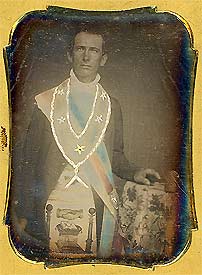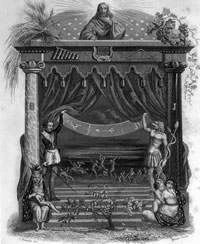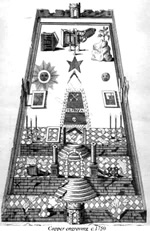

Freemasonry
Freemasonry is a fraternal organization whose membership is held together by shared moral and metaphysical ideals and—in most of its branches—by a constitutional declaration of belief in a Supreme Being.
 The fraternity of Freemasonry uses the allegorical metaphors of operative stonemasons' tools and implements against the backdrop of the building of the Temple of King Solomon, to convey what is most generally defined as: A peculiar (some say particular or beautiful) system of morality veiled in allegory and illustrated by symbols.
The fraternity of Freemasonry uses the allegorical metaphors of operative stonemasons' tools and implements against the backdrop of the building of the Temple of King Solomon, to convey what is most generally defined as: A peculiar (some say particular or beautiful) system of morality veiled in allegory and illustrated by symbols.
The Masonic Lodge
A Lodge, often termed a Private Lodge or Constituent Lodge in Constitutions, is the basic organization of Freemasonry. Every new Lodge must be warranted by a Grand Lodge, but is subject to its direction only in enforcing the published Constitution of the jurisdiction. A Lodge must hold full meetings regularly at published dates and places. It will elect, initiate and promote its own members and officers; and it will own, occupy or share premises, and will normally build up a collection of minutes, records and equipment.
A man can only be initiated, or made a Mason, in a Lodge, of which he may well remain a subscribing member for life. A Master Mason is generally entitled to visit any Lodge meeting under any jurisdiction in amity with his own; and a Lodge may well offer hospitality to such a visitor after the formal meeting. He is first usually required to check the regularity of that Lodge, and must be able to satisfy that Lodge of his own regularity; and he may be refused admission if adjudged likely to disrupt the harmony of the Lodge. If he wishes to visit the same Lodge repeatedly, he may be expected to join it, and pay a membership subscription.
Ritual and Symbolism
 Freemasonic ritual makes use of the architectural symbolism of the medieval operative Masons, who actually worked in stone. Freemasons, as Speculative Masons, use this symbolism to teach moral and ethical lessons of the principles of "Brotherly Love, Relief and Truth" — or as related in France: "Liberty, Equality, Fraternity".
Freemasonic ritual makes use of the architectural symbolism of the medieval operative Masons, who actually worked in stone. Freemasons, as Speculative Masons, use this symbolism to teach moral and ethical lessons of the principles of "Brotherly Love, Relief and Truth" — or as related in France: "Liberty, Equality, Fraternity".
Two of the principal symbols always found in a Lodge are the square and compasses; symbols always displayed in an open Lodge. Some Lodges and rituals explain these symbols as lesson in conduct: that one should "square their actions by the square of virtue" for example. However, as Freemasonry is non-dogmatic, there is no general interpretation for these symbols (or any Masonic symbol) that is used by Freemasonry as a whole.
These moral lessons are communicated in performance of allegorical ritual, based on solid foundations of Biblical sources. A candidate progresses through degrees gaining knowledge and understanding of himself, his relationship with others and his relationship with the Supreme Being, (as he interprets this for himself). After taking each degree, he will attend the same ritual many times, taking part in it from the different points of view of each office, until he knows it by heart — and so is in the best possible position to moralize about it, within the bounds of his own competence.
The balance between ritual, philosophical and spiritual, charitable service and social interchange varies between the Grand Lodges governing Freemasonry worldwide. History, philosophy and esoteric knowledge are of deep interest to many individuals. The philosophical aspects of the Craft tend to be discussed in Lodges of Instruction or Research, and sometimes informal groups. Freemasons, and others, frequently publish — to a variable degree of competence — studies that are available to the public. It is well noted, however, that no one person "speaks" for the whole of Freemasonry.
 The Volume of the Sacred Law is always displayed in an open Lodge. In English-speaking countries, this is frequently the King James Version of the Bible or another standard translation (there is no such thing as an exclusive "Masonic Bible"). In many French Lodges, the Masonic Constitutions are used. A candidate is given his choice of religious text for his Obligation, according to his beliefs. UGLE alludes to similarities to legal practice in the UK, and to a common source with other oath taking. Christian candidates will typically use the Lodge's Bible while those of other religions may choose another book that is holy to them, to be displayed alongside the Lodges' usual VSL. In Lodges with a membership of mixed religions it is common to find more than one sacred text displayed representing the beliefs of the individuals present.
The Volume of the Sacred Law is always displayed in an open Lodge. In English-speaking countries, this is frequently the King James Version of the Bible or another standard translation (there is no such thing as an exclusive "Masonic Bible"). In many French Lodges, the Masonic Constitutions are used. A candidate is given his choice of religious text for his Obligation, according to his beliefs. UGLE alludes to similarities to legal practice in the UK, and to a common source with other oath taking. Christian candidates will typically use the Lodge's Bible while those of other religions may choose another book that is holy to them, to be displayed alongside the Lodges' usual VSL. In Lodges with a membership of mixed religions it is common to find more than one sacred text displayed representing the beliefs of the individuals present.
In keeping with the geometrical and architectural theme of Freemasonry, the Supreme Being is referred to in Masonic ritual by the titles of the Great Architect of the Universe, Grand Geometer or similar forms of words to make clear that their reference is generic, not about any one religion's particular concept of God.
Degrees
The three degrees of Craft or Blue Lodge Freemasonry are those of:
-
Entered Apprentice (EA) - the degree of an Initiate, which makes a Mason
-
Fellow Craft (FC)- a fellow of a Lodge, comparable to a fellow of a college
-
Master Mason (MM)- the "third degree", a necessary qualification for election as the Worshipful Master (or in Scotland Right Worshipful Master) of his Lodge, which is an office not a degree.
A Past Master is a Master Mason who has served as Master of his Lodge; this is a rank, not a degree.
 The degrees represent stages of personal development. No Freemason is told that there is only one meaning to the allegories; as a Freemason works through the degrees and studies their lessons, he interprets them for himself, his personal interpretation being bounded only by the Constitution within which he works. A common symbolic structure and universal archetypes provide a means for each Freemason to come to his own answers to life's important philosophical questions.
The degrees represent stages of personal development. No Freemason is told that there is only one meaning to the allegories; as a Freemason works through the degrees and studies their lessons, he interprets them for himself, his personal interpretation being bounded only by the Constitution within which he works. A common symbolic structure and universal archetypes provide a means for each Freemason to come to his own answers to life's important philosophical questions.
For example, one interpretation of the three degrees is as follows: The Entered Apprentice is at the step of self-knowledge, the apprentice should recognize his own imperfection, which is symbolized by a rough stone, and should learn to discover and remove his own flaws. With these abilities, he is promoted into Fellow Craft with its symbol of the smooth worked rectangular stone. At the least, the Fellow should acquire the ability of self-control, a requirement to fit with the other Freemasons into the building of human society. The Master Mason is raised into the step of ennoblement, its symbol is the drawing board, containing abstracted plans and designs. The Master Mason should understand that all life is transient, and it is his duty to help others with his drawings to continue the building of humanity.
General requirements
Generally to be a regular Freemason, a man must:
* Be a man who comes of his own free will. Traditionally, Freemasons do not actively recruit new members
* Believe in a Supreme Being
* Be at least the minimum age (18–25 years depending on the jurisdiction, but commonly 21)
* Be of sound mind, body and of good morals, and of good repute
* Be free (or "born free", i.e. not born a slave or bondsman)
* Have one or two references from current Masons (depending on jurisdiction)
 A candidate is asked 'Do you believe in a Supreme Being?'. Since an initiate is obligated on that sacred volume which is applicable to his faith, a sponsor will enquire as to an appropriate volume once a decision has been made on the applicant's suitability for initiation.
A candidate is asked 'Do you believe in a Supreme Being?'. Since an initiate is obligated on that sacred volume which is applicable to his faith, a sponsor will enquire as to an appropriate volume once a decision has been made on the applicant's suitability for initiation.
A number of Grand Lodges allow a Lewis, (the son of a Mason), to be initiated earlier than the normal minimum age for that jurisdiction.
History
The first Grand Lodge formed in Freemasonry was The Grand Lodge of England (GLE), founded in 1717, when four existing London Lodges met for a joint dinner. This rapidly expanded into a regulatory body, which almost all English Lodges joined. From the 1750s onwards, two competing English Grand Lodges vied for supremacy - the "Moderns" (GLE) and "Ancients" (or Athol) Grand Lodges. They finally united in 1813 to form the present United Grand Lodge of England (UGLE).
The Grand Lodges of Scotland and Ireland were formed in the 1720s, and Freemasonry was exported to the British Colonies in North America by the 1730s - with the English "Ancients" and the "Moderns" Grand Lodges and the Grand Lodges of Scotland and Ireland chartering offspring ("daughter") Lodges, which in turn set up Provincial Grand Lodges. From the American Revolution, and again after the breach caused by "War of 1812", independent US Grand Lodges formed themselves within the State boundaries. Some thought was briefly given to organizing an over-arching "Grand Lodge of the United States", with George Washington as the first Grand Master, but the idea was short-lived. The various Grand Lodges did not wish to diminish their own authority by agreeing to such a body.
